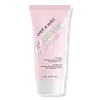What's inside
What's inside
 Key Ingredients
Key Ingredients

 Benefits
Benefits

 Concerns
Concerns

 Ingredients Side-by-side
Ingredients Side-by-side

Water
Skin ConditioningButylene Glycol
HumectantGlycerin
HumectantSodium Acrylates Crosspolymer-2
AbsorbentPhenoxyethanol
PreservativeEthylhexylglycerin
Skin ConditioningParfum
MaskingPhysalis Angulata Extract
Skin ProtectingCaprylic/Capric Triglyceride
MaskingPropanediol
SolventCaprylyl Glycol
EmollientHexylene Glycol
EmulsifyingPrunus Yedoensis Flower Extract
HumectantTocopherol
AntioxidantCI 17200
Cosmetic ColorantCI 19140
Cosmetic ColorantWater
Skin ConditioningAlcohol
AntimicrobialBambusa Arundinacea Stem Powder
AbrasiveHeptyl Undecylenate
EmollientPropanediol
SolventButylene Glycol
HumectantGlycerin
HumectantSqualane
EmollientSodium Acrylates Crosspolymer-2
AbsorbentPropylene Glycol
HumectantDimethicone
EmollientPolyacrylate Crosspolymer-6
Emulsion StabilisingSilica
AbrasiveHdi/Trimethylol Hexyllactone Crosspolymer
Niacinamide
SmoothingPhenoxyethanol
PreservativePolyurethane-35
Ethylhexylglycerin
Skin ConditioningSodium Phytate
Equisetum Arvense Extract
AstringentTocopherol
AntioxidantZinc PCA
HumectantMaltodextrin
AbsorbentMethylpropanediol
SolventSalvia Officinalis Oil
MaskingCaprylyl Glycol
EmollientSyringa Vulgaris Extract
Skin ConditioningPhenylpropanol
MaskingWater, Alcohol, Bambusa Arundinacea Stem Powder, Heptyl Undecylenate, Propanediol, Butylene Glycol, Glycerin, Squalane, Sodium Acrylates Crosspolymer-2, Propylene Glycol, Dimethicone, Polyacrylate Crosspolymer-6, Silica, Hdi/Trimethylol Hexyllactone Crosspolymer, Niacinamide, Phenoxyethanol, Polyurethane-35, Ethylhexylglycerin, Sodium Phytate, Equisetum Arvense Extract, Tocopherol, Zinc PCA, Maltodextrin, Methylpropanediol, Salvia Officinalis Oil, Caprylyl Glycol, Syringa Vulgaris Extract, Phenylpropanol
 Reviews
Reviews

Ingredients Explained
These ingredients are found in both products.
Ingredients higher up in an ingredient list are typically present in a larger amount.
Butylene Glycol (or BG) is used within cosmetic products for a few different reasons:
Overall, Butylene Glycol is a safe and well-rounded ingredient that works well with other ingredients.
Though this ingredient works well with most skin types, some people with sensitive skin may experience a reaction such as allergic rashes, closed comedones, or itchiness.
Learn more about Butylene GlycolCaprylyl Glycol is a humectant and emollient, meaning it attracts and preserves moisture.
It is a common ingredient in many products, especially those designed to hydrate skin. The primary benefits are retaining moisture, skin softening, and promoting a healthy skin barrier.
Though Caprylyl Glycol is an alcohol derived from fatty acids, it is not the kind that can dry out skin.
This ingredient is also used as a preservative to extend the life of products. It has slight antimicrobial properties.
Learn more about Caprylyl GlycolEthylhexylglycerin (we can't pronounce this either) is commonly used as a preservative and skin softener. It is derived from glyceryl.
You might see Ethylhexylglycerin often paired with other preservatives such as phenoxyethanol. Ethylhexylglycerin has been found to increase the effectiveness of these other preservatives.
Glycerin is already naturally found in your skin. It helps moisturize and protect your skin.
A study from 2016 found glycerin to be more effective as a humectant than AHAs and hyaluronic acid.
As a humectant, it helps the skin stay hydrated by pulling moisture to your skin. The low molecular weight of glycerin allows it to pull moisture into the deeper layers of your skin.
Hydrated skin improves your skin barrier; Your skin barrier helps protect against irritants and bacteria.
Glycerin has also been found to have antimicrobial and antiviral properties. Due to these properties, glycerin is often used in wound and burn treatments.
In cosmetics, glycerin is usually derived from plants such as soybean or palm. However, it can also be sourced from animals, such as tallow or animal fat.
This ingredient is organic, colorless, odorless, and non-toxic.
Glycerin is the name for this ingredient in American English. British English uses Glycerol/Glycerine.
Learn more about GlycerinPhenoxyethanol is a preservative that has germicide, antimicrobial, and aromatic properties. Studies show that phenoxyethanol can prevent microbial growth. By itself, it has a scent that is similar to that of a rose.
It's often used in formulations along with Caprylyl Glycol to preserve the shelf life of products.
Propanediol is an all-star ingredient. It softens, hydrates, and smooths the skin.
It’s often used to:
Propanediol is not likely to cause sensitivity and considered safe to use. It is derived from corn or petroleum with a clear color and no scent.
Learn more about PropanediolWe don't have a description for Sodium Acrylates Crosspolymer-2 yet.
Tocopherol (also known as Vitamin E) is a common antioxidant used to help protect the skin from free-radicals and strengthen the skin barrier. It's also fat soluble - this means our skin is great at absorbing it.
Vitamin E also helps keep your natural skin lipids healthy. Your lipid skin barrier naturally consists of lipids, ceramides, and fatty acids. Vitamin E offers extra protection for your skin’s lipid barrier, keeping your skin healthy and nourished.
Another benefit is a bit of UV protection. Vitamin E helps reduce the damage caused by UVB rays. (It should not replace your sunscreen). Combining it with Vitamin C can decrease sunburned cells and hyperpigmentation after UV exposure.
You might have noticed Vitamin E + C often paired together. This is because it is great at stabilizing Vitamin C. Using the two together helps increase the effectiveness of both ingredients.
There are often claims that Vitamin E can reduce/prevent scarring, but these claims haven't been confirmed by scientific research.
Learn more about TocopherolWater. It's the most common cosmetic ingredient of all. You'll usually see it at the top of ingredient lists, meaning that it makes up the largest part of the product.
So why is it so popular? Water most often acts as a solvent - this means that it helps dissolve other ingredients into the formulation.
You'll also recognize water as that liquid we all need to stay alive. If you see this, drink a glass of water. Stay hydrated!
Learn more about Water